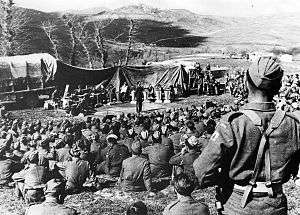The Red Poppies on Monte Cassino

Czerwone maki na Monte Cassino (The Red Poppies on Monte Cassino) is one of the best-known Polish military songs of World War II.[1] It was composed in May 1944 in Italy, during the Battle of Monte Cassino, on the eve of the Polish Army's capture of the German stronghold.
History
In early 1944 a German stronghold, dug in at the ancient Benedictine monastery atop Monte Cassino, had blocked the Allies' advance toward Rome. The forces of several Allied countries had attempted since mid-January to capture the German fortress. For a fourth major assault, which would begin on 11 May 1944, Polish troops were rotated in.[2]
The song's melody was composed during the night of 17–18 May 1944 by Alfred Schütz, a composer, actor and member of the Polish Soldiers' Theater garrisoned at Campobasso in the shadow of Monte Cassino.[3] Two opening stanzas were written at that time by Feliks Konarski ("Ref-ren" — "Refrain"), a poet and song-writer and soldier of the Polish II Corps commanded by Major General Władysław Anders.[3] The third stanza would be written a few days later.[3]
The third verse, Konarski wrote several hours later. In his memoirs, he wrote:
"For the first time singing Red poppies on Monte Cassino, we all cried. Soldiers cried with us. Red poppies, which bloomed over night, became one more symbol of bravery and sacrifice - a tribute of alive ones, whom for love of freedom died for freedom of people."
The fourth and final stanza would be written a quarter-century later, in 1969, to commemorate the 25th anniversary of the battle.[4] That final stanza is the least known and is sometimes omitted.[4]
On 18 May 1944, the day following the song's composition, the Poles stormed and captured the precincts of the Monte Cassino monastery. Later that day, the song was first performed at General Anders' headquarters to celebrate the Polish victory.[5] The Red Poppies on Monte Cassino won popularity with the troops and was soon published by a Polish-American newspaper in New York. It would later be published in Poland.[6] It was banned, however, during the Stalinist period in the People's Republic of Poland, when the government sought to minimize memory of the wartime Polish Armed Forces in the West.[7] It is featured, however, in Andrzej Wajda's film Ashes and Diamonds, made in 1958, after the death of Stalin.
Royalties for commercial use of the "Red Poppies" melody were paid - through German organization of collective management of copyright GEMA - to Free State of Bavaria (Germany), which - according to German law - acquired copyright after the childless death of Alfred Schutz and his wife in Munich as their heir.[8] In 2015 Bavaria transferred the copyright to Poland.[9]
See also
- Monte Cassino Commemorative Cross
- Polish Military Cemetery at Monte Cassino
- Polish Military Cemetery at Casamassima
- In Flanders Fields
References
- ↑ Brian Murdoch (24 May 1990). Fighting Songs and Warring Words: Popular Lyrics of Two World Wars. Psychology Press. p. 195. ISBN 978-0-415-03184-4. Retrieved 20 May 2012.
- ↑ Ken Ford (27 April 2004). Cassino 1944: Breaking the Gustav Line. Osprey Publishing. p. 84. ISBN 978-1-84176-623-2. Retrieved 18 May 2012.
- 1 2 3 (in Polish) Bogdan Okulski, description of the song in the Wojenko, wojenko album, 1995.
- 1 2 (in Polish) Jerzy Trzesicki, Cassino-tekst
- ↑ (in Polish) Bogdan Żurek, Czerwone maki, Radio Wolna Europa.
- ↑ (in Polish) Monografia "Czerwonych maków" - hymnu IX LO w Szczecinie
- ↑ Jeffrey C. Goldfarb (15 April 1992). Beyond Glasnost: The Post-Totalitarian Mind. University of Chicago Press. p. 63. ISBN 978-0-226-30098-6. Retrieved 20 May 2012.
- ↑ Bogusław Wieczorek, Royalties for playing unofficial national anthem of Poland go to Germany, Własność intelektualna w praktyce [2015-01-05].
- ↑ Ministry of Foreign Affairs Republic of Poland, Copyright on The Red Poppies on Monte Cassino transferred to Poland, [2015-09-14].
External links
- Text (Polish) and music
- Lyrics (Polish and English)
- Film showing the Polish 2nd Corps at Monte Cassino, with Czerwone maki na Monte Cassino played in the background on YouTube.